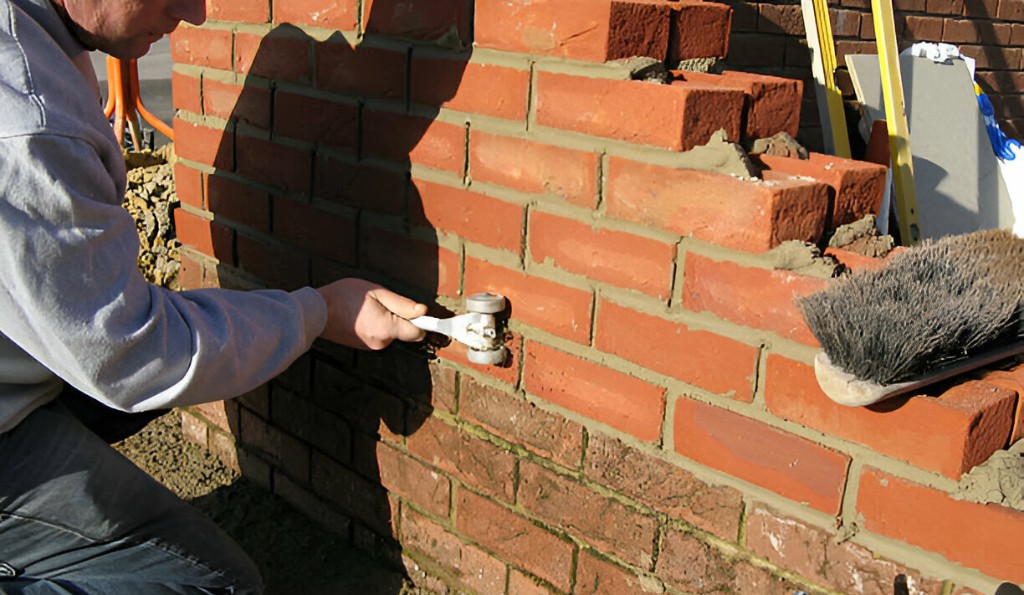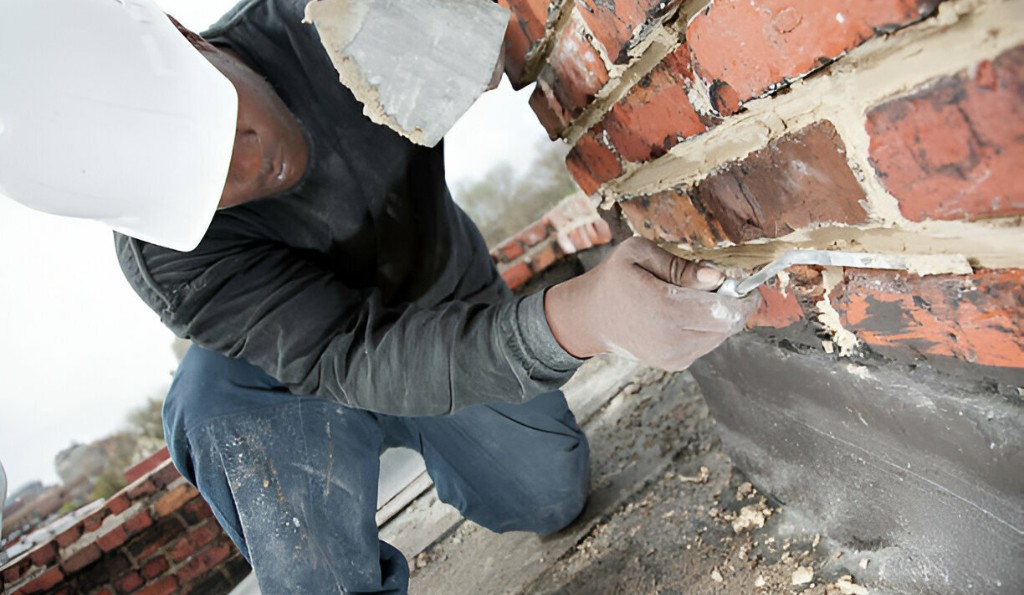When it comes to masonry, everyone has options to choose from, but the two common choices are brick and stone. But which one is better? That’s what this brick vs. stone masonry article will be about.
We will be looking at both options with wide-open eyes and see what they are all about. We will look at the pros and cons of each choice and we will tell you some of the differences between the two. By the end, you will know exactly which is right for your Brooklyn home.
What is Brick Masonry?
Brick masonry is one type of construction that uses bricks and mortar to build structures like walls, buildings, and homes. This method has been used for thousands of years and is still popular today because it is strong and lasts a long time.
How Brick Masonry is Done
Here is how brick masonry contractors perform their services:
Preparing the Site
First, the area where the structure will be built needs to be prepared. This means making sure the ground is level and stable. Sometimes, a foundation is built to support the weight of the brick structure.
Laying the Bricks
Bricks are laid in rows, called courses. A layer of mortar, which is a mixture of cement, sand, and water, is spread on the foundation or the previous course of bricks. The mortar acts like glue, holding the bricks together.
Aligning the Bricks
Each brick is carefully placed on the mortar and tapped into position to ensure level and alignment with the other bricks. Builders use tools like a spirit level and a string line to make sure the bricks are straight and even.
Cutting and Fitting Bricks
Sometimes, bricks need to be cut to fit into specific spaces or around corners. This is done using a brick chisel and a hammer or a special saw.
Adding More Courses
More rows of bricks are added on top of each other. Each new row is offset from the row below, creating a bond pattern. The most common bond is the running bond, where bricks are staggered so the vertical joints don’t line up.
Finishing the Joints
After laying the bricks, the mortar joints are finished. This can be done in different styles, such as concave, flush, or raked. This step makes the wall look nice and helps protect it from the weather.
Curing the Mortar
Once all the bricks are laid, the mortar needs time to dry and harden. This process is called curing. It usually takes a few days for the mortar to be fully set.
Pros of Brick Masonry
- Durability: Brick masonry is very strong and can last for many years. Bricks do not rot, dent, or need painting, which makes them a durable choice for buildings.
- Fire Resistance: Bricks can withstand high temperatures and do not burn easily. This makes brick buildings safer in case of a fire.
- Insulation: Brick walls help keep homes warm in the winter and cool in the summer. This factor saves money on heating and cooling bills.
- Low Maintenance: Brick masonry requires little maintenance over time. Unlike wood, bricks need not be repainted or treated for pests.
- Aesthetic Appeal: Bricks come in many colors and textures, making them a beautiful building choice. They give homes a classic and timeless look.
Cons of Brick Masonry
- Cost: Brick masonry can be expensive. The materials and the labor required to lay bricks are often more costly than other building methods.
- Weight: Bricks are heavy, making construction more difficult and requiring a strong foundation. This can also add to the overall cost.
- Limited Flexibility: Once a brick wall is built, it is hard to change. Remodeling or adding to a brick building can be more complicated compared to other materials.
What is Stone Masonry?
Stone masonry is another type of construction that uses stones and mortar to build structures like walls, buildings, and homes. Stone masonry is an ancient method with thousands of years of history and is still popular today because it is strong and beautiful.
How Stone Masonry is Done
Here is how stone masonry contractors perform their services:
Choosing the Stones
First, different types of stones are selected based on the design and purpose of the structure. Common stones used in masonry include granite, limestone, and sandstone. Each type of stone has its own look and characteristics.
Preparing the Site
The area where the structure will be built needs to be prepared. This means making sure the ground is level and stable. A strong foundation is often built to support the heavy stones.
Shaping the Stones
Stones are cut and shaped to fit the design of the structure. This can be done by hand using chisels and hammers or with special saws. Shaping the stones is important to make sure they fit together tightly.
Laying the Stones
Stones are placed on the foundation in rows, called courses. A layer of mortar, which is a mixture of cement, sand, and water, is spread between the stones. The mortar acts like glue, holding the stones together.
Aligning the Stones
Each stone is carefully positioned and aligned with the others. Builders use tools like levels and string lines to make sure the stones are straight and even. This step is important to ensure the strength and stability of the structure.
Building Upwards
More rows of stones are added on top of each other. Just like with bricks, the stones are often arranged in a pattern to create a strong bond. The arrangement can vary depending on the style of the structure.
Finishing the Joints
After all the stones are laid, the mortar joints are finished. This can be done in different styles, such as concave or flush. Finishing the joints helps protect the structure from the weather and gives it a neat appearance.
Curing the Mortar
Once the stones are in place, the mortar needs time to dry and harden. This process is called curing. It usually takes several days for the mortar to set fully and become strong.
Pros of Stone Masonry
- Durability: Stone masonry is very strong and lasts for many years. Stones do not rot, decay, or get damaged easily, making them durable for buildings.
- Natural Beauty: Stones come in various colors and textures, giving buildings a unique and beautiful appearance. Each stone is different, adding a natural and elegant look to the structure.
- Weather Resistance: Stone has been found to withstand harsh weather conditions, including heavy rain, snow, and wind, making stone masonry a good choice for areas with extreme weather.
- Low Maintenance: Stone masonry requires little maintenance over time. Unlike wood, stones do not need to be painted or treated for pests, saving time and money on upkeep.
- Fire Resistance: Stones do not burn, making stone masonry buildings very fire-resistant. This can help keep homes and buildings safe in case of a fire.
Cons of Stone Masonry
- Labor-Intensive: Building with stones takes a lot of time and effort. Skilled workers are needed to correctly shape and place the stones, which can raise labor costs.
- Limited Flexibility: It is hard to change once a stone wall or structure is built. Remodeling or adding to a stone building can be more complicated and expensive than other materials.
- Slow Construction: Stone masonry takes longer to build than other types of construction. Each stone’s careful placement and alignment mean the building process is slower.
Brick vs. Stone Masonry: Key Differences

Wall Thickness
Brick walls can be made as thin as 10 cm. However, stone walls are generally thicker, with a minimum thickness of 38 cm, providing more strength and stability.
Ease of Handling
Bricks are small and lightweight, making them easy to handle and work with. Stones are large and heavy, making them difficult to manage during construction.
Labor Requirements
Less skilled labor is needed for brick masonry than for stone masonry. Working with stones often requires specialized skills to correctly cut, shape, and place them.
Construction Complexity
Brickwork is more advanced and easier to standardize than stonework. No dressing is required for bricks, while proper dressing is necessary for stones to fit together well.
Chemical Resistance
Bricks can be affected by chemical reactions, especially in the presence of salts from urine or sewage. Stones, however, are not easily affected by such chemical substances.
Surface Treatment
Plaster is required on brickwork to protect the surface from environmental effects. Stonework usually does not need plaster, as stones are naturally weathering-resistant.
Availability
Stones are not readily available everywhere, making stone masonry feasible only in regions where stones are abundant. Bricks, on the other hand, can be produced locally and are widely available.
Further Reading: How Much Does It Cost to Hire Brick-Pointing Contractors?
Conclusion
We hope you have found your side of the brick vs. stone masonry debate. And there is quite a bit of debate because both of these choices come with their own pros and cons. Certain buildings are perfect for one of these choices more than the other. So, carefully look at the differences to figure out if your building will look better with one or the other. AKRoofing3D has many masonry experts who will be more than happy to assist you in making this decision. Contact us whenever you need masonry assistance.

